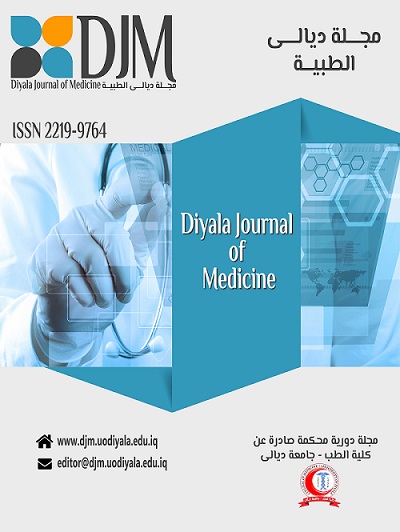Abstract
Background: Parkinson’s disease (PD) is a progressive neurodegenerative disorder
characterized by motor dysfunction and several non-motor features. Dysautonomia is a
significant non-motor feature as well as a neuropsychiatric symptom.
Objective: To assess cardiovascular autonomic function in Parkinson patients.
Patients and Methods: Samples were collected from Al Kadhimiya teaching hospital and
Baquba teaching hospital in a period lasts from 1st January to 1st November 2013.
Cardiovascular autonomic function had been tested in 44 Parkinson patients with autonomic
dysfunction, 23 Parkinson patients without autonomic dysfunction and 25 healthy matched
controls; using Valsalva maneuver, 30:15 ratio, and effect of posture on blood pressure.
Results: The most frequent dysautonomic symptoms in parkinson disease were fainting and
dizziness (postural hypotension) with a frequency of 26.8% with a P-value 0.015. The
comparison between valsalva levels in three groups of study population was significant (P-
value 0.04). The comparison between 30:15 ratio in three groups of study population was not
significant statistically (P-value 0.344).
Conclusion: Cardiovascular autonomic dysfunction is a common non-motor symptom
associated with Parkinson's disease. It may precede the development of the cardinal motor
symptoms in PD, making cardiovascular dysfunction an attractive target for early detection
and potential neuroprotective strategies for PD. Valsalva maneuver and effect of changes in
posture on blood pressure are affecting tests in cardiovascular autonomic study.
characterized by motor dysfunction and several non-motor features. Dysautonomia is a
significant non-motor feature as well as a neuropsychiatric symptom.
Objective: To assess cardiovascular autonomic function in Parkinson patients.
Patients and Methods: Samples were collected from Al Kadhimiya teaching hospital and
Baquba teaching hospital in a period lasts from 1st January to 1st November 2013.
Cardiovascular autonomic function had been tested in 44 Parkinson patients with autonomic
dysfunction, 23 Parkinson patients without autonomic dysfunction and 25 healthy matched
controls; using Valsalva maneuver, 30:15 ratio, and effect of posture on blood pressure.
Results: The most frequent dysautonomic symptoms in parkinson disease were fainting and
dizziness (postural hypotension) with a frequency of 26.8% with a P-value 0.015. The
comparison between valsalva levels in three groups of study population was significant (P-
value 0.04). The comparison between 30:15 ratio in three groups of study population was not
significant statistically (P-value 0.344).
Conclusion: Cardiovascular autonomic dysfunction is a common non-motor symptom
associated with Parkinson's disease. It may precede the development of the cardinal motor
symptoms in PD, making cardiovascular dysfunction an attractive target for early detection
and potential neuroprotective strategies for PD. Valsalva maneuver and effect of changes in
posture on blood pressure are affecting tests in cardiovascular autonomic study.
Keywords
Parkinson's disease; autonomic symptoms
Abstract
الخلفية: مرض باركنسون (PD) هو اضطراب تنكسي عصبي تدريجي
يتميز بالخلل الحركي والعديد من الميزات غير الحركية. خلل الحكم الذاتي هو
ميزة غير حركية كبيرة بالإضافة إلى أعراض نفسية عصبية.
الهدف: تقييم وظيفة اللاإرادية للقلب والأوعية الدموية في مرضى باركنسون.
المرضى والأساليب: تم جمع العينات من مستشفى الكاذمية التعليمي و
يستمر مستشفى باكوبا التعليمي في فترة من 1 يناير إلى 1 نوفمبر 2013.
تم اختبار وظيفة القلب والأوعية الدموية اللاإرادية في 44 مريضا باركنسون يعانون من اللاإرادي
خلل وظيفي، 23 مريضا بمرض باركنسون بدون خلل وظيفي لاإرادي و25 متطابقا صحيا
الضوابط؛ باستخدام مناورة فالسالفا، نسبة 30:15، وتأثير الموقف على ضغط الدم.
النتائج: كانت الأعراض الذاتية الأكثر شيوعا في مرض باركنسون هي الإغماء و
الدوخة (انخفاض ضغط الدم الوضعي) بتردد 26.8٪ مع قيمة P 0.015. الْ
كانت المقارنة بين مستويات فالسالفا في ثلاث مجموعات من مجموعة الدراسة كبيرة (P-
القيمة 0.04). لم تكن المقارنة بين نسبة 30:15 في ثلاث مجموعات من سكان الدراسة
مهم إحصائيا (قيمة P 0.344).
الخلاصة: الخلل اللاإرادي القلبي الوعائي هو أحد الأعراض الشائعة غير الحركية
مرتبط بمرض باركنسون. قد يسبق تطور المحرك الأساسي
الأعراض في PD، مما يجعل ضعف القلب والأوعية الدموية هدفا جذابا للكشف المبكر
واستراتيجيات الحماية العصبية المحتملة ل PD. مناورة فالسالفا وتأثير التغييرات في
يؤثر وضع ضغط الدم على الاختبارات في دراسة اللاإرادية للقلب والأوعية الدموية.
يتميز بالخلل الحركي والعديد من الميزات غير الحركية. خلل الحكم الذاتي هو
ميزة غير حركية كبيرة بالإضافة إلى أعراض نفسية عصبية.
الهدف: تقييم وظيفة اللاإرادية للقلب والأوعية الدموية في مرضى باركنسون.
المرضى والأساليب: تم جمع العينات من مستشفى الكاذمية التعليمي و
يستمر مستشفى باكوبا التعليمي في فترة من 1 يناير إلى 1 نوفمبر 2013.
تم اختبار وظيفة القلب والأوعية الدموية اللاإرادية في 44 مريضا باركنسون يعانون من اللاإرادي
خلل وظيفي، 23 مريضا بمرض باركنسون بدون خلل وظيفي لاإرادي و25 متطابقا صحيا
الضوابط؛ باستخدام مناورة فالسالفا، نسبة 30:15، وتأثير الموقف على ضغط الدم.
النتائج: كانت الأعراض الذاتية الأكثر شيوعا في مرض باركنسون هي الإغماء و
الدوخة (انخفاض ضغط الدم الوضعي) بتردد 26.8٪ مع قيمة P 0.015. الْ
كانت المقارنة بين مستويات فالسالفا في ثلاث مجموعات من مجموعة الدراسة كبيرة (P-
القيمة 0.04). لم تكن المقارنة بين نسبة 30:15 في ثلاث مجموعات من سكان الدراسة
مهم إحصائيا (قيمة P 0.344).
الخلاصة: الخلل اللاإرادي القلبي الوعائي هو أحد الأعراض الشائعة غير الحركية
مرتبط بمرض باركنسون. قد يسبق تطور المحرك الأساسي
الأعراض في PD، مما يجعل ضعف القلب والأوعية الدموية هدفا جذابا للكشف المبكر
واستراتيجيات الحماية العصبية المحتملة ل PD. مناورة فالسالفا وتأثير التغييرات في
يؤثر وضع ضغط الدم على الاختبارات في دراسة اللاإرادية للقلب والأوعية الدموية.
Keywords
مرض باركنسون؛ الأعراض اللاإرادية، الأعراض غير
